3 Workshop Guide & Resources
Self-Portrait Collage as a Methodology:
Collaging works well as an activity not only because of its inherent affordability and sustainability, but also because it reflects the essential process of identity making–we create with what we have available. Collaging is the process of creating art from the combination of materials in a new composition, with the origins of the term coming from the French word to stick or glue together. The art form has long been used to express ideas in a non-linear and abstract fashion, which is partially why the interest in the “epistemological potential of collaging [is] increasing amongst social scientists” (Kangas 6). For queer students, this activity opens doors for personal expression and applies critical theory to an area of their lives that may be unarticulated or even muted in other contexts. For students who do not identify as LGBTQ+, this activity can also aid them in viewing Queer Theory as an area of academia that applies to us all every single day, rather than as a lens to view a group outside of themselves.
Workshop Documents:
OER Collage Workshop Presentation:
https://drive.google.com/file/d/1i2yz0eotnIrtQlj-xclcZGtsCKdYnRoE/view?usp=sharing
Booklet Example:
https://drive.google.com/file/d/1kooPyD8qHbGBK2izqKbZaE-bs6Eh1jC-/view?usp=sharing
OER Script Gender Abolition Workshop:
https://drive.google.com/file/d/1zGiGRDKZlvZ2CE9go5KVpmCm2YwoOPGF/view?usp=sharing
Collage Sheets:
https://drive.google.com/file/d/1ZvF3ugmHFrtyfTPZ49d05H905t0ImpbH/view?usp=sharing
If you encounter any issues accessing these Workshop Documents please contact oer@weber.edu.
Preparing for the Workshop:
Materials Needed:
- Scissors or x-acto knives. Students can also be encouraged to rip out their images if there isn’t a cutting utensil available.
- Adhesives, such as glue or tape. Most students preferred glue sticks or clear tape.
- Paper for Base: Some students chose to use the pre-cut paper to begin their collage, but many used an image directly from the materials to serve as their background.
- Supplemental Tools: Rulers, markers, paper punches, stencils, and patterned scissors can inspire participants to further experiment with their creative process beyond their image and composition choices.
- Table Coverings: To avoid leaving glue and marker lines on the table, extra pieces of paper from an unused notepad, scrap, or recycled paper can be offered to cover each student’s workstation. Alternatively, large swaths of butcher paper or newspaper can be placed on tables before beginning the workshop.
- Traditional Collaging Materials: Illustrated books, magazines, calendars or pamphlets with images, patterned paper, and other visual materials all work for collaging.
- Supplemental Creative Materials: Stickers, fabric scraps, buttons, plastic pulled from recycling bins, expired polaroid film, and more unexpected materials were incorporated into participants’ collages. If you can figure out a way to attach it to paper, students will likely find a way to use it.
Collecting Affordable Materials:
Gathering enough materials is the most difficult and time consuming part of the workshop. However, there are plenty of free resources available that can help.
- DIY Printing: Plenty of free images and illustrations can be found online and printed to be used in these pieces. This can be especially helpful if you hope to evoke conversations around specific imagery. However, I recommend prioritizing recycled materials for sustainability reasons[a][b][c].
- Social Media Outreach: Posting on Facebook was the most helpful, with posts being made on a page for the university’s professors and a local “Buy Nothing” page. Most county or city areas have created a page for exchanging items people no longer want, with many allowing you to make requests for specific items.
- Sample Script: “Hello all! I am hosting an activity for my students [insert date here]. I am hoping to collect magazines or books with plenty of photos [alternatively: scissors, glue, etc…] for them to be able to use in their creative projects. Please let me know if you have any items you would be willing to donate and I will DM you for when/where I can come pick them up!”
- Free Newspaper and Magazine Stands: You can find these outside of grocery stores, but I found the most success by targeting local coffee shops and restaurants. Many businesses allowed me to take multiple copies or even extra stock of past months publications simply by asking the person working the front stand.
- Sample Script: “Hi! I noticed you have quite a few copies of [insert publication] here. Would you mind if I took a few extra copies for a project I’m helping my students with?”
- Campus and Local Libraries: Because many libraries have ongoing subscriptions to magazines but a limited amount of space, they may discard these items for the public or be willing to gift you them directly. Discarded books are less likely to have pictures and may require a glance before using them in the workshop, but can be just as effective.
- Note: Try reaching out to your campus library administration or contacting your local library system for materials to recycle. They may also have an extra supply of scissors, glue, and scrap paper.
- Free Little Libraries: Free Little Libraries can be found in neighborhoods, community centers, or through the map on the app “FreeLittleLibrary.” These have the added benefit of being available to browse at all hours, but may not always have books with images or other collage materials.
- Note: Little libraries near schools or higher income neighborhoods tend to be overflowing with extra books that are suitable for collaging. If I notice a library is running low, I try to exchange one of my own fiction or poetry books in return.
- Local Ads: Your area may have its own local online ad website where people post items for sale or trade, or you can search by mile radius on Facebook Marketplace. I found people posted fairly frequently with free magazines from old subscriptions that they hoped to have repurposed instead of thrown away. This format requires more individual correspondence, but by choosing ads that contain a larger amount of materials, can significantly help.
- Thrift Stores: If you have funds available, thrift stores can be great places to locate picture-based books and magazines. After gathering as many free materials as possible, I visited my local Savers (like a Goodwill) to fill in the gaps I was missing.
- For example, I chose to purchase a few copies of men’s pop culture and health magazines, a vintage doll catalogue, and a few science books geared towards children.
Instructor Preparation:
I recommend you create your own self-portrait before hosting the workshop yourself. This not only allows you to immerse yourself in the experience of the students so that you can provide better guidance and feedback during the activity, but also provide an additional example for the participants. A great time to share your piece is during the final transition from prompts to free time for collaging or while showing examples of other collages. Sharing a personal description of the creative process and meaning behind your piece showcases a vulnerability that can inspire participants to more deeply engage with their work.
Self-Reflexive Turn:
A self-reflexive turn refers to a change in the academic writing style from the author portraying themselves as an objective observer to a more transparent and critical articulation of the researcher or educator’s own position. Authors – and instructors – approach any topic through analyzing their own socio-political background, their identity, and the experiences which result from these factors. As academia becomes more aware of unconscious biases and privilege, self-reflexive turns have become more popular.
This framework steps away from the concept of a “carefully cultivated academic self,” instead pointing scholars toward a culture of accountability and vulnerability that inspires an “unfiltered humanity alongside critical theory” (Van Klinken 16). In his research on Christian and queer culture in Kenya, Van Klinken uses self-reflexive turns to aid his fieldwork as a “white European academic working in a neoliberal and often neocolonial academic context” – one not dissimilar to my own in many cases (Van Klinken 16). As a white academic in a heavily religious state who did not share the major religion with the student population and could not be immediately identified as trans, I felt this technique was vital to employ in engaging with this workshop.
However, a self-reflexive turn cannot be used as a way to disperse worries of bias, but must rather confront them head on. Self reflexivity is more than just turning the gaze inwards; it is about developing a mindset of equality, and even “love,” to commit yourself to a decolonial approach to scholarship. This requires taking “an interest in understanding and enhancing our shared human condition in a divided and fragmented world” (Van Klinken 21). Such an approach is vital for a workshop on gender abolition due to how deeply homophobic and transphobic ideas are subtly in Western culture to the point they do not immediately rise to the surface, instead remaining a hegemonic background to our teaching. The educational world itself has notably suffered the effects of this as LGBTQ+ student centers and programs are actively being removed from campuses as a result of conservative policies, even at my own university.
Incorporating a self-reflexive into my workshop preparation and collaging process encouraged me to look at the assumptions I carry about teaching, explore how I feel un/grounded in my body while presenting, consider ways to deconstruct hierarchy in the classroom, and evaluate my own position as a someone who is able to passively conceal my gender identity. For educators who do not identify as queer, this can also be an opportunity to consider the language and approach you typically take to this subject area. By taking time for self-reflexivity prior to doing this workshop, you can explore what feelings and biases you have about queerness, gender, and your own body in pedagogical spaces.
Educator Example:
The following self-reflection was written by Dr. Elaine Schnabel, a professor who identifies as both straight and cisgender. She engaged in the workshop as a full participant and then wrote this reflection about the collage she created.
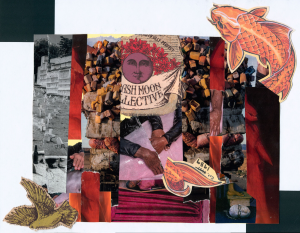
“During the workshop, I gravitated toward three images in particular: a pink dolphin with men’s hands clutching at its body, a set of fierce-looking red figures against a black background, and an overburdened truck that trundles gamely onward along the road. I cut up these images and spliced them together because I rarely feel all these things all the time, but at different times these ways of engaging with my identity emerge. The dolphin image gets at that feeling of others, particularly men, feeling a right to my body: having something to say about it or touch me or tell me something about myself without asking me about myself. I often feel trapped by men’s emotional needs and expectations. The red, demonic-looking figures with teeth are my (at times vicious) response to that treatment. Gloria Anzaluda writes of the “shadowbeast” inside all women and folks who are Other in some way–a part of us that cannot be tamed and will always disturb those who try to pin us down. I love that part of my identity. I think it comes from my femininity but also my solidarity from that position with anyone else whose felt hands all over their bodies and minds. So I often think of my ability to be vicious as a privilege, something I as a cisgender and straight (white) woman can get away with that my contemporaries of color or friends who are queer cannot. The final central image–that of a truck overburdened with trash, but driving forward anyway–is somewhat gendered. Like a lot of women, I feel busy a lot of the time and overburdened with caring for the needs of others. But I also think this image is more about the capitalistic productivity imperatives that all genders live under right now: we’re working, working, working ourselves to death (hence the cemetery image to the left of the piece and a girl in a coffin at the bottom) and pretending it means something. I think it’s gross (trash) that I’m very good at working that way, in a way that those who are less able cannot. And yet there’s a lightness to the color in that image that I’m drawn to–a burden I take on gladly because I hope the work matters.”
Setting Up Your Workshop:
This stage will vary depending on your classroom, but the easiest set up I found was arranging a few different collections of random printed materials around the room at each desk group. The table at the front of the room intended for educator use became the station for students to pick up tools such as glue and scissors, as well as supplemental creative materials that couldn’t be evenly distributed across the classroom. At the beginning of class or as students filter in, they can be instructed to collect the basic items they will most likely need and any other material that catches their interest.
Closing the Workshop & Student Progress:
It is expected that some students may not finish their collage during class time, so envelopes, sandwich bags, or folders can provided for students to take their selected materials home and finish the process by themselves. This can be reminded to participants who may seem stressed or rushed due to the perceived time restraints.
Alternatively, some students may finish significantly earlier than others. Whether this results from a lack of desire to deeply engage in the activity or simply their natural speed, students should be reengaged with additional prompts or direct interaction. In the classroom, this continual reengagement has given start to some of the most unexpected and even confrontational design choices.
- Prompt Example: Similar to our idea of “queer” being something that confronts or lies outside of the social norms, try adding one or more elements that may feel unexpected in your collage.
Post-Workshop Reflection:
A written or verbally-shared reflection from participants following the workshop allows for an opportunity for critical analysis that can further connect the dots between the personal and political elements of this workshop. This can be done as a free writing exercise where students write about anything that remained with them following the activity. Participants may be further engaged by specific prompts, such as:
- Did your collage diverge from what you originally pictured or intended? Was there any particular content from the workshop that caused that change?
- Did you encounter any challenges while constructing your collage? Did any negative feelings arise as a result?
Workshop Format:
Workshop Length:
While the lesson script is built to cover an introduction to the topic and allow students time to complete their self-portrait in one class session, it can easily be split into two different days. The first day can be presented as a traditional lecture by selecting readings from the resources section and covering their main points with opportunities for discussion or questions to the class incorporated throughout. The second day can begin with a brief summary of this material before starting with the first prompt. You may use this additional time for students to spend more time to freely engage with the creative process, or implement portions of time for written or verbally shared reflections to the prompts.
Adjusting for Hybrid or Online Platforms:
While it is recommended to facilitate this lesson in-person, it can be reformatted to fit an online or hybrid format through your preferred meeting program. Students can create a free account on Canva (canva.com), an easy to use site that has plenty of free images and illustrations, as well as the ability to incorporate text, shapes, and moving design elements. However, a drawback of using this program is that participants will have to search for keywords in order to find images. If you go this route, the workshop can help offset this by incorporating a section where participants are asked to think of key terms or visual descriptors for themselves which they will then search for.
Participant Examples:
Below is a selection of student examples and a paragraph they wrote to debrief after the workshop, with some edited for length or spelling errors.
Example # 1

Jenny: “I tried to illustrate two sides. The green side represents things that the world is or tells me I should be/do. These images are pictures of beautiful, white, slender women, exercise equipment, fresh whole foods, and the words; “loud world”, “Moms get fit”, and “Working mothers” which I crossed out. For me, these are the type of images and messages that I grew up with. These messages created the conditions of possibility that enabled me to develop into someone with a deeply seated need to fit in, please others, and be thin. In my adolescent life, this type of discourse created conditions that filled me with doubt and resulted in eating disorders and self loathing because I could never reach the ideals that were put upon me.
In the middle are a few merging phrases that represent how the ideal and reality are brought together in my life. One of those phrases is “Can I get a word in?” This is indicative of my desire to have my own voice and opinions be heard in a loud world.
On the left side of the page, those images represent more of who I actually am or want to be. There are pictures of foods I love, cooking, mother and child, nature, the words, “noticer” and “work in progress”. Overall, this was an amazing assignment and really allowed me to reflect on some deep things that needed attention. I appreciate it!”
Example # 2
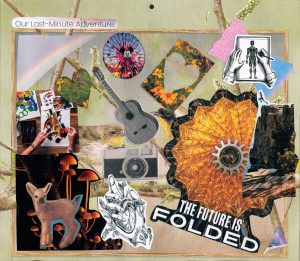
Fawn: “1. I believe that the guitar, the deer, the trans flag, and the camera represent who I really am. Being a trans man, I named myself after a baby deer, hence the name ‘Fawn’ because I felt that it represented who I am as a person and what I want to be seen as. As for the guitar and camera, I use both of those as a way to express myself. Both photography and guitar/music are something that I’m very passionate about because I feel like some of the only ways to express ‘me’ are through art and music.
2. I picked the image of the man jumping off the cliff as part of my collage because I feel like society expects me to be assertive, daring, and brave as a trans guy, even when I don’t feel like any of those. I think that people often forget that I am just as human as anybody else and that my emotions aren’t automatically ‘shut off’ or something because of my identity.
3. An accurate way to describe parts of my identity that feel ‘given’ is the picture on the top right where a man is being drawn with a pencil. I feel like I have to sculpt myself into being the ‘perfect man’, otherwise I am never going to be seen as myself by the outside world. People closest to me know that I don’t always care about fitting into the standards put upon cis men, but sometimes I make myself fit those standards out of fear and isolation. I fear that if I don’t blend in enough, no one will take me seriously and I’ll just be another one of “those” people.
4. I was hesitant to include the images of the flowers and the mushrooms on my collage, as I was scared that it’d ‘disregard’ my masculinity because those things are typically seen as feminine. This also goes for the image of the Ferris wheel at Disneyland. It’s hard to feel valid in my identity when I do like feminine things, and sometimes it makes me jealous of cis men who have that privilege of liking traditionally ‘feminine’ things, without the same repercussions I may be faced with. I also remember being drawn to a picture of a torn-up dress but ultimately[e] decided not to include it for the same reasons.”
Example #3
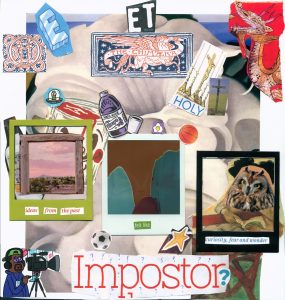
Ethan: “I feel like at my core, I am a person that is made up of many different things. I started with the image in the middle because for some reason I felt like it accurately portrayed me ethnically and that is like my “base.” The image on the left represents the past and how it is a beautiful window and that I am a very nostalgic person while the image on the right represents the future and how I continue to seek knowledge (owl and reading). Most of the food and activities are more representative of what society wants me to be. Like I said earlier, my ethnic makeup is diverse. Because of what makes me up, I feel like it’s an expected joke and stereotype that I should like these sports or these foods like the grape juice, basketball, and soccer (which I do like, but it brings up the question of why do I like it and how did I start to like it?). I’m not sure if I would say it’s given or necessary but the big “Impostor” at the bottom is sort of like a mask that comes on and off. Sometimes, it feels like I know who I am, who I was made to be, and who I’m becoming, but it’s also easy to feel like I’m not actually living up to the things that I have supposedly accomplished. Am I really a good filmmaker/photographer (bottom left)? Am I good at these sports? Am I truly intelligent or just a fool reading books for pride? I think this ties back altogether to the title of “Chimaera.” A beast made up from parts of other beautiful beasts. Whether it’s beautiful or a monster in disguise is all a matter of perspective.”
Example #4
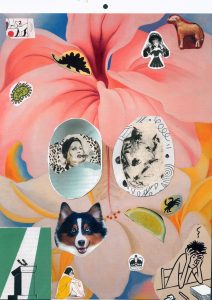
Lilly: “In my collage, I have a podium in the bottom left corner. This is a large part of my identity, taking up space, having a captive audience and attention on me. To the right of this image there is an image of a woman in yellow sitting alone, she appears to be contemplating something. These two images placed next to each other resonated with me because I often feel like while I feel comfortable with attention, I often spend a lot of time rethinking how I am perceived. There are lots of images of femininity in this collage. There are two images in the center, one a drawing of a blonde woman with a cigarette, I placed her over cheetah print (my favorite color) and then breaking out of an egg. I resonated with this because I am someone who is pretty feminine presenting, but there are some traits that I have been told are “unbecoming, unlady-like” that are just itching to break out of the societal norms. I also have a small pageant girl in a dress, showcasing my admiration for femininity.”
Example #5

Lance: “I tried to only pick pictures that I thought represented me. I like food, I like sports, winter, and games. Pictures like the bear thing, and the lama are what I think society sees me as. I am a tall individual with a long neck. I also hope that society sees me as a chill guy which is why I put that picture in the top right. […] If I was to redo this poster, I would have done more planning and tried to stick to a specific side of myself. Though I still like the randomness and somewhat of a color pattern that this poster has, and that was on purpose.”
Example #6
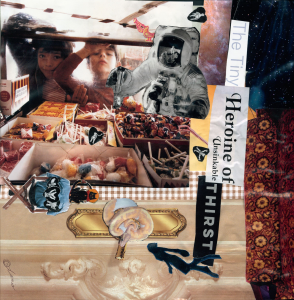
Lamis: “I see myself as the little bird with the horn perched near the astronaut, as well as the diver aiming for the yellow door. I am a strange combination of interests, and I like to dive deep in whatever is fascinating me, but I can be fickle. I also think the person sitting on the filmmaking chair is an identity I’ve given myself. I removed the original person’s head and put a black cat because that is another symbol that I think can describe me well. My collage also has a motif of secrecy and barriers: snake, closed door, glass display, filmmaker with back turned, black cat. I think this was subconscious; I wanted to express that I am guarded but I was surprised how much it showed up in the work.
I was also trying to communicate my identity as an immigrant or ‘alien’ or ‘Other’ by incorporating the astronaut. It feels like an identity that is negotiated both by me and others. In legal aspects, I am assigned that label which affects my conditions of possibility in the U.S. In my everyday life, I am reminded of that label and how or how not I have embraced that has shaped my identity as an immigrant. I think it’s a cheeky juxtaposition–viewing astronauts like immigrants, space research as some sort of galactic study abroad.”
Media Attributions
- Instructor Example © Dr. Schnabel is licensed under a CC BY-NC (Attribution NonCommercial) license
- Participant Example © Jenny is licensed under a CC BY-NC (Attribution NonCommercial) license
- Participant Example © Fawn is licensed under a CC BY-NC (Attribution NonCommercial) license
- Ethan – Participant Example © Jazmyne Olson is licensed under a CC BY-NC (Attribution NonCommercial) license
- Participant Example © Lilly is licensed under a CC BY-NC (Attribution NonCommercial) license
- Participant Example © Lance is licensed under a CC BY-NC (Attribution NonCommercial) license
- Participant Example © Lamis is licensed under a CC BY-NC (Attribution NonCommercial) license

